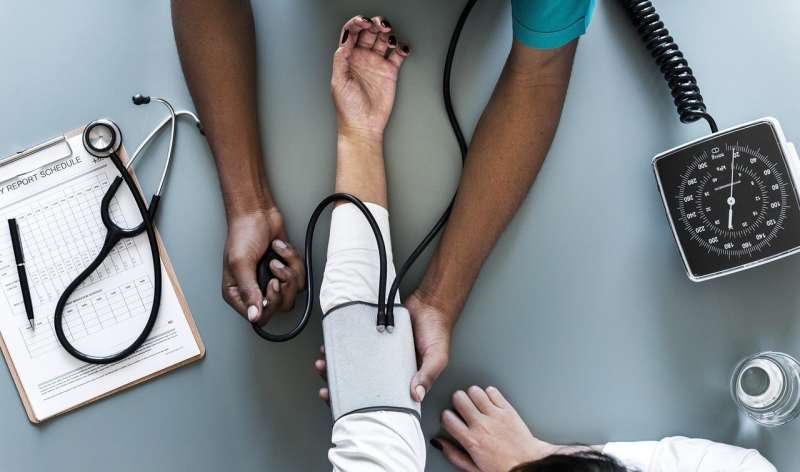Nine out of ten patients with high blood pressure need more treatment

Hypertension (high blood pressure) is the leading treatable cause of illness and death worldwide. More than a billion people are hypertensive, defined as having blood pressure (BP) with a systolic level (the higher number) of at least 140 millimeters of mercury (mmHg) or diastolic level (the lower number) of 90 mmHg or higher.
More than a quarter of all adults in Sweden have hypertension. This condition increases the risk of several dangerous illnesses, such as myocardial infarction (heart attack) and stroke, and of dying prematurely. For some patient categories, the most advantageous BP levels in terms of avoiding myocardial infarction (MI) and stroke are uncertain.
In one of the studies in his thesis at Sahlgrenska Academy, University of Gothenburg, specialist doctor Johan-Emil Bager studied the association between various BP levels and the risk of MI or stroke in older patients with hypertension but without a history of heart attacks or strokes.
Lower risk at lower blood pressure
The risk of MI or stroke was found to be some 40 percent lower for the patients with systolic blood pressure (SBP) below 130 mmHg, compared with those in the SBP 130–139 range. In the latter group, 5.2 percent of the patients suffered a heart attack or stroke during the follow-up period, compared with 3.4 percent of those in the group with lower SBP. The study comprised 5,041 older patients.
This pattern was repeated in another study, which investigated the risk of hemorrhagic stroke (brain bleed) at different blood pressure levels in 3,972 patients with atrial fibrillation, a common type of heart rhythm disorder. These patients were receiving treatment with blood-thinning drugs, such as Warfarin or Eliquis.
The study showed that patients with SBP ranging from 140 to 179 mmHg had a risk of hemorrhagic stroke roughly twice as high as for patients with SBP of 130–139 mmHg. In the patient group with higher SBP, 1.4 percent suffered a hemorrhagic stroke during the follow-up period, compared with 0.7 percent of patients in the group with lower SBP.
Not enough treatment
In another study, comprising data on 259,753 patients, the insuffiency of treatment in patients with hypertension emerged. Nine out of ten patients had either insufficient BP control or high blood lipids (cholesterol), or were smokers.
"This means that an overwhelming majority of the patients with high blood pressure are exposed to at least one important, modifiable risk factor for cardiovascular disease and premature death," Johan-Emil Bager says.
He concludes that an unnecessarily high number of people in Sweden suffer MI or stroke, or die prematurely, because of insufficiently treated hypertension.
"Health professionals and patients with hypertension alike need to aim higher when it comes to treating high blood pressure. The vast majority of patients with hypertension could reduce their MI and stroke risk by lowering their BP and blood lipids with more drugs, or through lifestyle changes."
More information: Johan-Emil Bager et al, Acute blood pressure levels and long-term outcome in ischemic stroke, Brain and Behavior (2018). DOI: 10.1002/brb3.992
Johan-Emil Bager et al, Treatment of hypertension in old patients without previous cardiovascular disease, Journal of Hypertension (2019). DOI: 10.1097/HJH.0000000000002163
Johan-Emil Bager et al, Blood pressure levels and risk of haemorrhagic stroke in patients with atrial fibrillation and oral anticoagulants: results from The Swedish Primary Care Cardiovascular Database of Skaraborg, Journal of Hypertension (2021). DOI: 10.1097/HJH.0000000000002838
Johan-Emil Bager et al, Trends in blood pressure, blood lipids, and smoking from 259 753 patients with hypertension in a Swedish primary care register: results from QregPV, European Journal of Preventive Cardiology (2021). DOI: 10.1093/eurjpc/zwab087




















